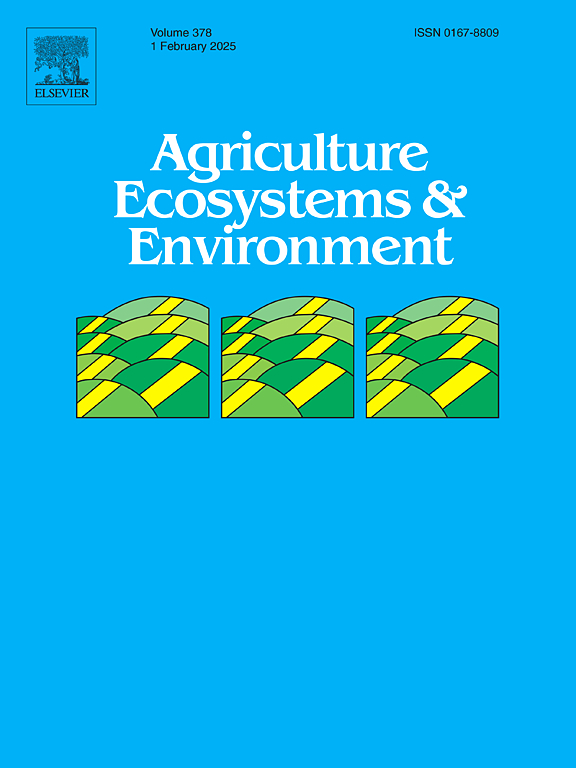巴西塞拉多地区作物多样化战略和气候变化情景下土壤有机质变化建模
IF 6.4
1区 农林科学
Q1 AGRICULTURE, MULTIDISCIPLINARY
引用次数: 0
摘要
在巴西,土地转换和农业管理历来是该国温室气体(GHG)排放的最大来源,而塞拉多地区则是受影响最严重的地区之一。虽然种植多样化被认为是通过土壤有机碳(SOC)固存来减少温室气体排放的一种潜在战略,但这些系统对塞拉多地区的长期影响尚不清楚。我们使用 DayCent 模型模拟了直到 2070 年(50 年)作物多样化和耕作对 SOC 动态的影响,包括气候变化情景下常见的作物连作系统和与覆盖作物相关的轮作系统。首先,我们利用该地区三个地点的植物和土壤观测数据对 DayCent 模型进行了校准和评估,其中作物产量、SOC 和氮的皮尔逊系数(r 值)分别为 0.50 至 0.94(校准地点)和 0.53 至 0.99(验证地点)。然后,我们利用该模型研究了种植系统和气候如何相互作用来控制 SOC 水平。结果表明,在大豆-棉花长期(∼50 年)连作下,无论土壤管理如何,SOC 储量都会减少(-0.04 至 -0.17 兆克碳-公顷-年-1)。采用轮作和覆盖作物(即小米、糙米草、苘麻)的作物多样化具有最高的 SOC 累积潜力(∼0.71 Mg C ha-1 year-1),到 2070 年,SOC 储量可达 130 Mg C ha-1。在作物连作系统中,莴苣(Ruzigrass),无论是单一种植还是与玉米间作,都显示出固着 SOC 的巨大潜力(∼0.55 兆克碳/公顷-年-1),如果实施更复杂的轮作不可行,这可能是一个可行的策略。到 2070 年,在 SSP2 - 4.5 和 SSP5 - 8.5 气候变化情景下,各处理的 SOC 储量分别增加了 6.3% 和 8.2%。研究结果表明,多样化耕作系统是增加 SOC 固存的一种有前途的策略,并为加强该地区目前的管理实践提供了宝贵的指导。本文章由计算机程序翻译,如有差异,请以英文原文为准。
Modeling soil organic matter changes under crop diversification strategies and climate change scenarios in the Brazilian Cerrado
In Brazil, land conversion and agricultural management have historically accounted for the largest share of the country's greenhouse gas (GHG) emissions, with the Cerrado region being one of the most affected areas. Although cropping diversification has been proposed as a potential strategy to mitigate GHG emissions through soil organic carbon (SOC) sequestration, the long-term effects of these systems in the Cerrado are unknown. The DayCent model was used to simulate the impact of crop diversification and tillage on SOC dynamics until 2070 (∼50 years), including common crop succession systems and crop rotations associated with cover crops under climate change scenarios. First, we calibrated and evaluated the DayCent model using plant and soil observations from three sites in the region, where Pearson coefficients (r values) ranged from 0.50 to 0.94 (calibration sites) and 0.53–0.99 (validation site) for crop yields, SOC, and nitrogen. We then used the model to investigate how cropping systems and climate interact to control SOC levels. Results indicate that SOC stocks would decrease under the long-term (∼50 years) soybean-cotton succession, regardless of soil management (-0.04 to −0.17 Mg C ha−1 year−1). Crop diversification with crop rotation and cover crops (i.e., millet, ruzigrass, sunn hemp) had the highest SOC accrual potential (∼0.71 Mg C ha−1 year−1), resulting in SOC stocks of up to 130 Mg C ha−1 by 2070. Ruzigrass, either single or intercropped with maize on crop succession systems, showed substantial potential for SOC sequestration (∼0.55 Mg C ha−1 year−1) and could be a viable strategy if implementing more complex rotations is not feasible. The SSP2 – 4.5 and SSP5 – 8.5 climate change scenarios increased SOC stocks by 6.3 and 8.2 % in SOC across treatments by 2070, respectively. Results suggest that diversified cropping systems are a promising strategy for increasing SOC sequestration, and they offer valuable guidance for enhancing current management practices in the region.
求助全文
通过发布文献求助,成功后即可免费获取论文全文。
去求助
来源期刊

Agriculture, Ecosystems & Environment
环境科学-环境科学
CiteScore
11.70
自引率
9.10%
发文量
392
审稿时长
26 days
期刊介绍:
Agriculture, Ecosystems and Environment publishes scientific articles dealing with the interface between agroecosystems and the natural environment, specifically how agriculture influences the environment and how changes in that environment impact agroecosystems. Preference is given to papers from experimental and observational research at the field, system or landscape level, from studies that enhance our understanding of processes using data-based biophysical modelling, and papers that bridge scientific disciplines and integrate knowledge. All papers should be placed in an international or wide comparative context.
 求助内容:
求助内容: 应助结果提醒方式:
应助结果提醒方式:


